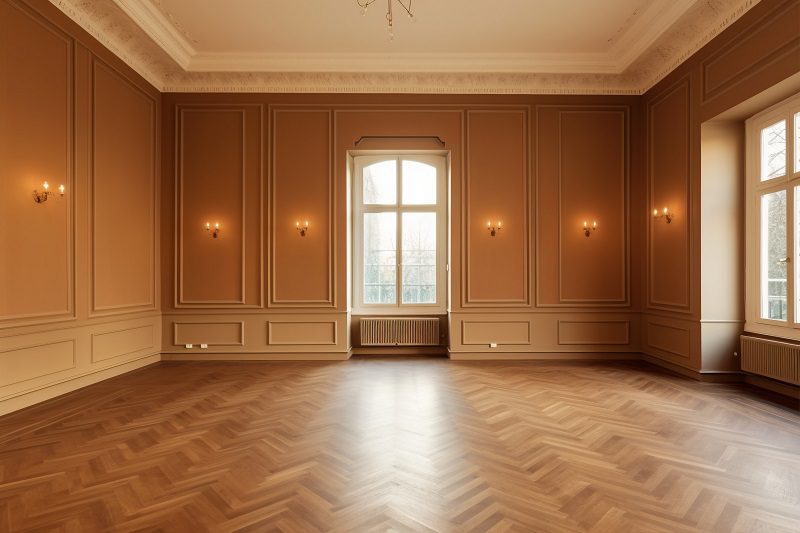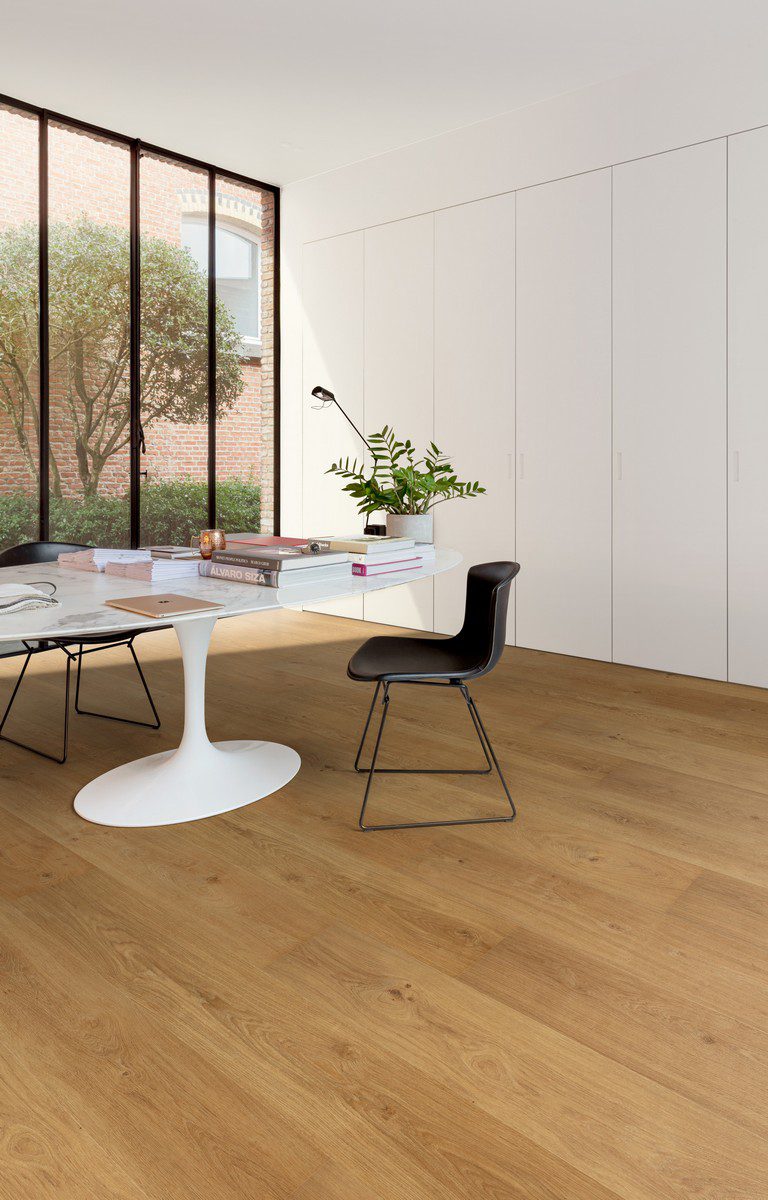Have you ever wondered what exactly parquet flooring is and how it differs from traditional hardwood flooring? We will explore the various types of parquet flooring, including solid wood, engineered wood, laminate, and vinyl options.
Discover the benefits of choosing parquet flooring, as well as the preparation and installation process. Learn how to properly maintain and care for your parquet flooring to keep it looking beautiful for years to come.
Stay tuned to learn all about this stylish and durable flooring option!
What Is Parquet Flooring?
Parquet flooring is a type of flooring made from wood blocks arranged in geometric patterns like herringbone. It is a popular choice for adding elegance and warmth to a room.
One of the defining characteristics of parquet flooring is its intricate patterns, which often create a sense of luxury and sophistication in any space. The composition of parquet flooring typically consists of different types of wood, such as oak, walnut, or maple, that are carefully crafted to form visually appealing designs.
Parquet flooring patterns can range from classic herringbone to elaborate chevron or basket weave designs, allowing for a wide range of styles to suit various interior aesthetics. The unique patterns not only add visual interest but also enhance the texture and depth of the flooring, making it a standout feature in any room.
The Difference Between Parquet Flooring and Hardwood Flooring
Whilst both parquet flooring and hardwood flooring are made from wood, the key difference lies in their installation patterns. Parquet flooring features intricate geometric designs, whilst hardwood flooring consists of planks in straight or random patterns.
Parquet flooring is renowned for its design versatility, allowing for endless possibilities in creating stunning patterns like herringbone, chevron, and basketweave. This distinctive feature adds a touch of elegance and sophistication to any space, making it a popular choice for interior designers and homeowners seeking a unique aesthetic.
Types of Parquet Flooring
Parquet flooring comes in various types, including solid wood parquet, engineered wood parquet, laminate parquet, and vinyl parquet. Each type offers distinct features and benefits.
a. Solid Wood Parquet
Solid wood parquet is crafted from 100% natural woodblocks without any additional layers. It provides a timeless and luxurious look to any room.
Solid wood parquet flooring is renowned for its exceptional durability and strength, making it ideal for high-traffic areas in homes and commercial spaces. The natural beauty of the wood adds warmth and character to the surroundings, creating an inviting and cosy ambience.
Long-lasting and resistant to wear and tear, solid wood parquet is a wise investment that increases the value of your property while requiring minimal maintenance. Regular sweeping and occasional polishing are usually sufficient to keep the flooring looking at its best.
The installation process of solid wood parquet involves intricate craftsmanship as each woodblock is meticulously placed to create intricate patterns and designs. Professional installation ensures a seamless finish and enhances the overall aesthetic appeal of the space.
b. Engineered Wood Parquet
Engineered wood parquet consists of a top layer of real wood bonded to multiple layers of plywood or fibreboard. It offers increased stability and resistance to moisture.
This construction method provides the beauty and elegance of real wood flooring while enhancing durability and minimising the risk of warping or cupping in high-moisture environments. The versatile nature of engineered wood parquet allows for a wide range of design options, including various wood species, finishes, and patterns, making it suitable for different interior styles.
- Engineered wood parquet is a cost-effective alternative to solid hardwood flooring, offering similar aesthetic appeal at a more budget-friendly price point.
- Its compatibility with underfloor heating systems makes it a practical choice for homes seeking efficient heating solutions.

See product: Lionvest Solid Oak Parquet – 197 – Brushed & Matt Lacquered
c. Laminate Parquet
Laminate parquet is a cost-effective alternative to solid wood flooring, featuring a printed layer that mimics the appearance of real wood. It is easy to install and maintain.
This type of flooring is popular for its affordability, making it an economical choice for homeowners who want a stylish look without breaking the bank. Along with being budget-friendly, laminate parquet is also known for its scratch resistance, making it a practical option for high-traffic areas in the home. With a wide range of designs available, from traditional oak to modern grey tones, there is a style to suit every taste and decor.
d. Vinyl Parquet
Vinyl parquet flooring offers a durable and waterproof option for households with high foot traffic. It comes in various styles that replicate the look of natural materials.
One of the standout features of vinyl parquet flooring is its water resistance, making it ideal for areas prone to moisture like kitchens and bathrooms. Its low-maintenance nature means that it is effortless to clean, requiring only regular sweeping and occasional mopping.
Vinyl parquet flooring provides a comfortable underfoot feel, offering a soft cushioning effect that can reduce strain on joints and muscles. The installation methods for this type of flooring vary, with options for glue-down, click-lock, or loose lay, allowing for flexibility based on the room’s requirements.

See product: Karndean Art Select Parquet Spring Oak
Benefits of Parquet Flooring
Parquet flooring offers several benefits, including exceptional durability, easy maintenance, and a wide range of designs and patterns to suit various interior styles.
a. Durability
One of the key benefits of parquet flooring is its durability, as it can withstand heavy foot traffic and daily wear and tear without losing its appeal.
Parquet flooring is crafted from layers of wood that are bonded together, creating a sturdy and resilient surface. This construction makes it highly resistant to scratches and dents, ensuring that the flooring maintains its beautiful appearance even in high-traffic areas.
Parquet flooring is known for its ability to resist fading caused by sunlight and other environmental factors, preserving its colour and finish over time. Choosing the right finish for your parquet floor is crucial in enhancing its longevity, as it adds an extra layer of protection against stains, moisture, and other forms of damage.
b. Easy Maintenance
Parquet flooring is known for its easy maintenance requirements, requiring regular sweeping and occasional mopping to keep it looking pristine.
Along with regular cleaning, parquet flooring longevity can be enhanced by using suitable cleaning products designed specifically for wood floors. Avoid using harsh chemicals or abrasive cleaning tools that could damage the surface. It’s crucial to prevent excessive moisture exposure as it can lead to warping or discolouration. Promptly addressing spills or stains with a damp cloth and gentle cleaner can prevent them from seeping into the wood. Taking these preventive care measures will not only maintain the beauty of your parquet flooring but also prolong its lifespan.
c. Variety of Designs and Patterns
One of the standout features of parquet flooring is the diverse range of designs and patterns available, allowing homeowners to customise their floors to match their interior decor.
Among the most popular design options are herringbone, chevron, and basketweave, each offering a unique visual appeal. A herringbone pattern, for instance, creates a classic and sophisticated look, ideal for formal spaces. On the other hand, a chevron pattern adds a modern twist with its V-shaped design, adding dynamic movement to a room. Meanwhile, a basketweave pattern brings a touch of elegance, reminiscent of traditional craftsmanship.
The choice of layout can greatly impact the overall aesthetics of a room. For instance, a herringbone pattern can visually widen a space and draw the eye towards a focal point, while a chevron pattern can create a sense of movement and direction. A basket-weave pattern, with its intricate interlocking design, can add texture and depth to a room.
How to Lay Parquet Flooring Guide: Preparation
Proper preparation is essential before installing parquet flooring, which includes measuring and ordering materials, preparing the subfloor, and acclimatising the flooring to the room’s environment.
1. Measuring and Ordering Materials
First preparation guide on how to lay parquet flooring is measuring the room dimensions accurately and ordering the right amount of parquet flooring and accessories are crucial steps to ensure a seamless installation process.
Start by measuring the length and width of the room in metres, multiplying the two values to get the total square meterage.
When ordering parquet flooring, it’s recommended to add 10% extra to account for wastage, cutting mistakes, and any future repairs.
Calculate the required adhesive and underlay by checking the manufacturer’s guidelines; always purchase a bit more than the exact measurement.
Consider purchasing additional tools such as a floor cutter, spacers, and a rubber mallet for a smooth installation process.
2. Preparing the Subfloor
Preparing the subfloor involves ensuring it is clean, flat, and dry before laying the parquet flooring to prevent issues like unevenness or squeaking.
- Moisture testing is a crucial step to assess if the subfloor is dry enough to proceed with the installation. Excessive moisture can lead to warping or buckling of the parquet flooring over time.
- Next, levelling the subfloor is essential to create a smooth surface for the parquet tiles. This can be done using self-levelling compounds or plywood sheets to correct any dips or bumps.
- Addressing any existing damage or imperfections, such as cracks or rot, is vital to prevent further issues down the line. Applying a suitable primer or underlayment can help enhance the adhesion and durability of the parquet flooring.
3. Acclimating the Parquet Flooring
Allowing the parquet flooring to acclimate to the room’s temperature and humidity levels for a specified period is essential to prevent issues like warping or buckling post-installation.
During the acclimatisation process, it’s crucial to follow manufacturer guidelines for the ideal duration, which typically ranges from 48 to 72 hours. Engineered hardwood flooring may need a shorter acclimatisation period compared to solid hardwood due to its construction.
When storing the flooring, ensure it’s kept in a dry, flat area away from direct sunlight and extreme temperature fluctuations. Avoid stacking the planks too tightly to allow for proper airflow. Utilising a moisture meter can help monitor the conditions and ensure the flooring is ready for installation.
How to Lay Parquet Flooring Guide: Installation Process
The installation process for parquet flooring involves laying the first row, filling in the gaps, and finishing and sealing the floor for a polished look.
Before starting the installation, ensure that the subfloor is clean, level, and dry. Begin by laying out the pattern you desire, considering the room’s dimensions for a balanced look.
1. Laying the First Row
Properly laying the first row of parquet flooring sets the foundation for the entire installation, ensuring alignment, stability, and a seamless transition to subsequent rows.
To achieve a flawlessly laid first row of parquet flooring, you will need various tools and techniques. Start by using a hammer, tapping block, and spacers to ensure each woodblock is snugly positioned with a small gap between them. Staggering the woodblocks means starting each subsequent row with the cut-off piece from the previous row to create a seamless and visually appealing pattern. It’s essential to maintain expansion gaps around the edges of the room to allow for natural movement of the wood. Before proceeding, always check the straightness of the first row using a straight edge to guarantee a uniform and professional finish.
2. Filling in the Gaps
After laying the main flooring, filling in any gaps or spaces between the woodblocks is essential for both aesthetic appeal and structural integrity.
One common method to fill these gaps is by using wood putty, a thick paste that is applied with a putty knife and then sanded down to create a smooth surface. Another option is to use filler strips, which are thin strips of wood cut to size and inserted into the gaps.
If you encounter irregular gaps that vary in width, consider mixing sawdust with the wood putty to create a custom filler that matches the colour and texture of the flooring. This ensures a seamless finish and disguises any imperfections.
3. Finishing and Sealing the Floor
To protect and enhance the appearance of parquet flooring, finishing and sealing the surface with the appropriate products is crucial for long-term durability and visual appeal.
- Oils: Applying oils can give the floor a natural and matte finish, enhancing the wood’s grain and warmth. Oiled finishes are easy to maintain and can be repaired locally if damaged.
- Lacquers: Lacquers provide a strong protective layer that is resistant to scratches and water damage, making them ideal for high-traffic areas. They offer a glossy finish that adds a modern touch to the flooring.
- Waxes: Waxes create a soft, warm glow on the floor while offering moderate protection. They are easy to apply and repair, making them suitable for DIY projects.
Once you have chosen the appropriate finish, it’s essential to apply a sealant to preserve the floor’s condition. Start by cleaning the surface thoroughly to remove any dirt or debris. Then, apply the sealant evenly using a brush or roller, following the manufacturer’s instructions. Allow the sealant to dry completely before moving the furniture back onto the floor. Regularly cleaning and reapplying the sealant will help extend the lifespan of your parquet flooring, keeping it looking beautiful for years to come.
Maintenance and Care for Parquet Flooring
Proper maintenance and care are essential for preserving the beauty and integrity of parquet flooring, including regular cleaning, scratch prevention, and refinishing when needed.
a. Regular Cleaning
Regular cleaning of parquet flooring involves sweeping or hoovering to remove debris, followed by mopping with a damp cloth or specialised wood floor cleaner for a thorough clean.
To maintain the beauty and longevity of your parquet flooring, it’s crucial to avoid harsh chemicals that can damage the wood’s finish.
Opt for non-abrasive cleaners specifically formulated for wood floors to ensure gentle yet effective cleaning.
Be cautious with moisture levels; excessive water can seep into the wood, leading to warping or buckling.
Additionally, promptly address any spills or stains to prevent them from setting and causing permanent damage.
Performing routine maintenance tasks such as polishing and resealing will help protect the surface and keep your parquet flooring looking its best.
b. Avoiding Scratches and Damage
Preventing scratches and damage on parquet flooring involves using furniture protectors, rugs, and gentle cleaning tools to maintain the surface integrity and appearance.
Placing felt pads under the legs of chairs and tables can effectively prevent scratches caused by furniture movement.
Strategically placing rugs in high-traffic areas like hallways and entryways can help minimise wear and tear on the flooring. It’s also important to conduct regular inspections for any signs of damage such as cracks, scratches, or discoloration.
By implementing these protective measures and staying proactive in maintenance, one can prolong the lifespan and beauty of their parquet flooring.
c. Refinishing and Repairing the Floor
When parquet flooring shows signs of wear or damage, refinishing and repairing techniques can help restore its beauty. This may involve sanding, resealing, or replacing damaged sections.
Surface sanding is typically the first step in refinishing parquet flooring. This process involves removing the existing finish to reveal a fresh surface. Once the sanding is complete, a new finish, such as varnish or wax, can be applied to enhance the floor’s appearance and protect it from future wear.
For deeper scratches or gouges, filling them with wood filler that matches the flooring’s color can help conceal imperfections. After filling, sanding the area smoothly and applying a matching finish can seamlessly blend the repair into the rest of the floor.
If the damage is extensive or if you prefer professional assistance, hiring a flooring contractor experienced in parquet repairs is recommended. They can assess the floor’s condition, provide expert advice, and carry out the necessary repairs with precision.
These are the complete guide on how to lay parquet flooring that you can follow. Once again, it’s best to consider using a professional and trusted flooring fitting service to avoid any risks.
If you use flooring fitting services from TEKA Flooring, then you don’t need to worry because there is a 24-month warranty. Furthermore, TEKA Flooring’s team of experts also have a combined experience of more than 30 years, so the quality is guaranteed. Call us today to get a FREE quote on 01733 731 930.
Read also:














